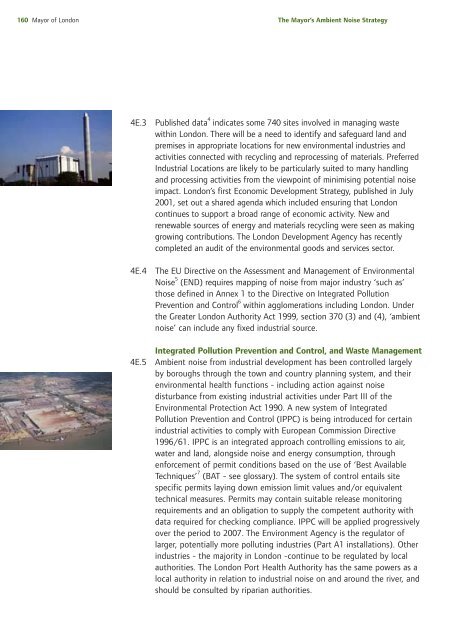The Mayor's Ambient Noise Strategy - Greater London Authority
The Mayor's Ambient Noise Strategy - Greater London Authority
The Mayor's Ambient Noise Strategy - Greater London Authority
Create successful ePaper yourself
Turn your PDF publications into a flip-book with our unique Google optimized e-Paper software.
160 Mayor of <strong>London</strong><br />
<strong>The</strong> Mayor’s <strong>Ambient</strong> <strong>Noise</strong> <strong>Strategy</strong><br />
4E.3 Published data 4 indicates some 740 sites involved in managing waste<br />
within <strong>London</strong>. <strong>The</strong>re will be a need to identify and safeguard land and<br />
premises in appropriate locations for new environmental industries and<br />
activities connected with recycling and reprocessing of materials. Preferred<br />
Industrial Locations are likely to be particularly suited to many handling<br />
and processing activities from the viewpoint of minimising potential noise<br />
impact. <strong>London</strong>’s first Economic Development <strong>Strategy</strong>, published in July<br />
2001, set out a shared agenda which included ensuring that <strong>London</strong><br />
continues to support a broad range of economic activity. New and<br />
renewable sources of energy and materials recycling were seen as making<br />
growing contributions. <strong>The</strong> <strong>London</strong> Development Agency has recently<br />
completed an audit of the environmental goods and services sector.<br />
4E.4 <strong>The</strong> EU Directive on the Assessment and Management of Environmental<br />
<strong>Noise</strong> 5 (END) requires mapping of noise from major industry ‘such as’<br />
those defined in Annex 1 to the Directive on Integrated Pollution<br />
Prevention and Control 6 within agglomerations including <strong>London</strong>. Under<br />
the <strong>Greater</strong> <strong>London</strong> <strong>Authority</strong> Act 1999, section 370 (3) and (4), ‘ambient<br />
noise’ can include any fixed industrial source.<br />
Integrated Pollution Prevention and Control, and Waste Management<br />
4E.5 <strong>Ambient</strong> noise from industrial development has been controlled largely<br />
by boroughs through the town and country planning system, and their<br />
environmental health functions - including action against noise<br />
disturbance from existing industrial activities under Part III of the<br />
Environmental Protection Act 1990. A new system of Integrated<br />
Pollution Prevention and Control (IPPC) is being introduced for certain<br />
industrial activities to comply with European Commission Directive<br />
1996/61. IPPC is an integrated approach controlling emissions to air,<br />
water and land, alongside noise and energy consumption, through<br />
enforcement of permit conditions based on the use of ‘Best Available<br />
Techniques’ 7 (BAT - see glossary). <strong>The</strong> system of control entails site<br />
specific permits laying down emission limit values and/or equivalent<br />
technical measures. Permits may contain suitable release monitoring<br />
requirements and an obligation to supply the competent authority with<br />
data required for checking compliance. IPPC will be applied progressively<br />
over the period to 2007. <strong>The</strong> Environment Agency is the regulator of<br />
larger, potentially more polluting industries (Part A1 installations). Other<br />
industries - the majority in <strong>London</strong> -continue to be regulated by local<br />
authorities. <strong>The</strong> <strong>London</strong> Port Health <strong>Authority</strong> has the same powers as a<br />
local authority in relation to industrial noise on and around the river, and<br />
should be consulted by riparian authorities.
















